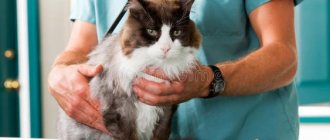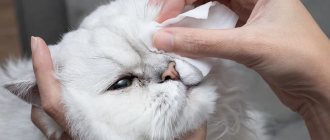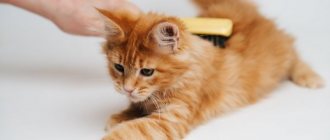Loving owners of their pets are wondering whether British cats need to be washed and what is the correct bathing procedure for British kittens. Questions about hygiene are important not only for people, but also for animals. After all, you want to stroke and pick up a clean and well-groomed cat. Also, if you do not bathe your pet, the risk of contracting a disease or infection increases. Remember that there are special rules for doing this.
At what age is it better to adopt a kitten?
Owners who are not familiar with the characteristics of the breed try to pick up a British kitten from a breeder at the age of 5-8 weeks. You should not do this, since caring for a pet at this age can be difficult. Of course, I want to watch the baby grow. However, early separation from your cat can have dire consequences for the kitten's health.
The appropriate age for moving to a new home is 10-12 weeks. By this time, the Briton is no longer dependent on his mother. He received a full course of breastfeeding, so his immunity is less vulnerable.
As a rule, a kitten at 12 weeks is already accustomed to the tray and knows how to use a scratching post. But the most important thing is that upon reaching the age of three months, the first vaccination against deadly diseases is carried out:
- rabies;
- chlamydia;
- panleukopenia;
- calcivirosis.
Taking an unvaccinated British kitten from a cattery is risky. Moreover, in case of complications after vaccination, the problems will fall on the shoulders of the new owner, not the breeder.
What you need to prepare for your baby
Caring for British kittens begins long before the pet moves to a new home. The future owner of the animal must prepare the house and buy everything necessary.
Before picking up a cat from the cattery, to ensure its safety you need to:
- secure the sockets well;
- hide wires lying on the floor;
- remove fragile objects from the shelves so that the kitten does not break them during games;
- put mosquito nets on the windows.
Equipment you will need to care for a British kitten:
- A carrier for transporting an animal.
- Tray and shovel for removing feces.
- Filler. This can be sawdust, clumping granular sand or silicate gel. It is better to check with the breeder what kind of filler the British kitten is used to.
- A bed or house where the cat will rest.
- Dishes. You will need bowls for food and water - 2 smaller ones, one large.
- Scratching post.
- Toys - rubber and fluffy balls, interactive mice, sticks with feathers at the end.
In addition to equipment, you will also need products for caring for a British kitten:
- shampoo and conditioner;
- furminator and massage mitt for removing loose hairs;
- daily eye care product;
- ear hygiene lotion;
- cotton pads;
- nail clipper;
- cat toothpaste and brush;
- first aid kit - pipette, electronic thermometer, hydrogen peroxide or chlorhexidine solution, bandage.
How to bathe cats correctly?
Each procedure for washing a pet must be carried out according to the rules. Any caring owner should know how to approach a pet. Main stages:
- First you need to comb the wool, untangle the tangles, if any;
- protect your ears with cotton balls;
- clear space in the bathroom from any foreign objects that the animal can throw off;
- Fill the bathroom with a basin of warm water up to about the level of Murka’s belly. It is advisable to do this without the presence of an animal;
- The body temperature of the cat family is slightly higher than that of humans, so the water temperature should be between 37-38° ;
- the pet needs to be calmed down, carefully placed in a container of water and given time to get used to it;
- You need to water your pet carefully from a ladle or glass, avoiding the area near the ears;
- Apply shampoo evenly to wet fur and leave for 1-2 minutes;
- It is very important to completely rinse off the detergent, as it weighs down the coat and dries out the skin;
- There is no need to rub the cat with a towel after washing. It is enough to wrap your pet in it and allow the fabric to simply absorb moisture;
- If the animal’s nerves are fine, then you can use a hairdryer to dry it.
The first days of a pet in the house
British kittens have good adaptive qualities. The baby will get used to the new home in about 3 days. The task of family members is to show where the tray, bowls of food and water, and bed are located. It is advisable to place your pet in one room first. And when he gets used to it a little, you can give him the opportunity to explore other rooms. At first, the kitten will hide and sniff everything. He is unlikely to want to play and respond to affection.
You need to ask the children not to frighten the pet or be too intrusive. When the kitten gets used to it a little, it will begin to come out of its hiding place to eat or go to the toilet.
At such moments, you can gently stroke him, take him in your arms, and talk in a gentle voice. It is worth offering him a treat so that he understands that the new owner is not a threat.
What not to do:
- forcefully pull the kitten out of its hiding place;
- sit and hold an animal in your arms against its will;
- force to play;
- squeeze, hug the British tightly;
- make noise.
With the appearance of a pet in the house, you need to watch your step so as not to step on it. You should close the toilet lid and check the contents of the drum before using the washing machine. Residents of the apartment must close the front door, otherwise the kitten may run away.
Toilet training
Typically, breeders give away kittens that already know how to use a litter box. However, if the animal was taken too early, you will have to train it to the toilet yourself.
To make the learning process easy and without problems, it is advisable to choose a convenient tray and filler for your British cat. The container should not be too high, otherwise it will be uncomfortable for the baby to go inside. As your Brit gets older, you can buy a new toilet with larger sides so that sand doesn't spill onto the floor when you bury it.
It is important to choose a place for the tray where the kitten can do its business without witnesses. If someone constantly walks near the toilet, the pet will prefer to relieve itself somewhere under the bed.
It is advisable to check with the breeder what kind of litter the kitten is used to and use the same one. Many Brits don't like to use scented sand, so opt for unscented sand. To help your kitten get used to the litter box faster, you need to put a napkin with the smell of his urine inside. Experienced felinologists recommend putting your little Briton in the toilet every 1.5-2 hours.
Why wash British cats?
So, in order for the fur of British cats to retain their iridescent shine and remain in perfect condition, they need to be washed periodically - no more than once every two months. This can be attributed to preventive purposes and aesthetic considerations of the owners.
Another reason to bathe your cat may be the presence of parasites in its fur. If she has picked up fleas or other pests, then the medicinal products against them must then be thoroughly washed off (along with traces of the vital activity of the parasites). It also happens that a cat got very dirty somewhere: it ran out into the street in the mud and rain, did not maintain coordination in the litter box, got smeared with food in the kitchen, etc. In such cases, bathing is carried out out of turn, but in accordance with the usual rules.
How to care for a British kitten
Keeping a British shorthair cat will not cause much trouble for the owner. Only the pet's eyes and ears need enhanced care.
Eye care
To care for a kitten's eyes, cotton pads and a special solution for daily hygiene, for example, “Diamond Eyes,” are used. If you don’t have it on hand, you can rinse your eyelids with warm boiled water, a weak chamomile decoction or saline solution.
A Briton's eyes need to be looked after every day. It is advisable to accustom your cat to this from an early age, so that in the future he will accept the procedure normally.
Before cleaning your eyes, you need to arm yourself with several cotton pads and solution. The British kitten must be in a good mood - you should not tear him away from an exciting game. It's better to wait until he sits quietly.
The pet is placed on the table or in your arms, fixed, and then the eyelids are wiped with a moistened sponge in the direction from the outer corner to the inner. Each side is treated with a clean cotton pad.
Normally, the discharge from the eyes of British cats is light brown or clear. If during the examination greenish, brown or yellow profuse discharge is detected, you need to show the kitten to a veterinarian. This indicates an inflammatory process. You cannot postpone your visit to the clinic; this can lead to complete or partial loss of vision.
Ear care
The owner of a British kitten should evaluate the condition of his ears once a week. Normally, there is a thin layer of wax in the external auditory canal. It resembles a light waxy coating and performs a protective function. However, its excess must be removed. This requirement does not only apply to British Fold kittens who cannot clean their ears on their own.
The procedure is carried out approximately once every 2 weeks using cotton pads soaked in lotion. If special care products are not at hand, you can use a chlorhexidine solution. The auricle is turned out and wiped thoroughly.
If there is a dark brown mass inside, there are scratches on the skin near the ears, and the kitten shakes its head frequently, you should contact your veterinarian. Such symptoms appear when infected with otodectosis.
Signs of the disease cannot be ignored, otherwise otitis media may develop. Regular care of your British kitten's ears will help prevent infection or detect alarming symptoms in time and begin treatment.
Grooming
The thick coat of a British kitten needs good care. In short-haired pets, it does not get tangled, but it still needs to be combed out. The British are very clean, they love to lick themselves. This is where the danger lies - the fallen hairs get into the stomach and can cause intestinal blockage.
The wool is combed out with a furminator and a massage brush with silicone tips. The procedure is usually carried out 2 times a week. During shedding, coat care is carried out daily.
Nail care
British kittens often suffer from fungal nail infections, so it is important to pay attention to their care. It is advisable to examine your pet's paws once a week.
If the nails are severely peeling or have dark spots on them, it is better to contact a veterinarian to diagnose the fungus. Once the diagnosis is confirmed, the kitten will be prescribed medicinal ointments.
Caring for claws involves shortening them. Even if a cat actively uses a scratching post, the claws still grow back quickly. In advanced cases, they curl up and grow into the pads of the paws, causing pain when walking. Once every 2 weeks, it is recommended for a British cat to trim its claws using a nail clipper.
Attention! Only the very tip, no more than 1 mm long, is cut off, since further on there is living tissue in which the capillaries are located. If it is damaged, there is a risk of infection.
Dental care
British kittens rarely have tooth decay. However, representatives of this breed often suffer from tartar, which leads to the development of gingivitis. To avoid inflammation of the gums, a kitten is taught to brush its teeth from an early age, from about 2 months. You will need a brush for small children and toothpaste for animals, which can be purchased at a veterinary pharmacy.
Cleaning is done once a week. It is very important to try to completely remove plaque. This must be done quickly and carefully. The most important thing in dental care is regularity.
If the cat has already developed tartar, it will be removed by a veterinarian under anesthesia, since this procedure is unpleasant and quite painful.
Hygiene procedures
It is not recommended to bathe British kittens under one year of age. The exception is very dirty fur. Representatives of this breed are not very enthusiastic about being in water; only some enjoy washing. Therefore, the British do not bathe often - 4-5 times a year. Most often this is done before visiting an exhibition.
To care for a thick plush coat, use only cat shampoo. To wash a cat, add a little water to the bath at a temperature of +38...+40 degrees. The wool is wetted using a ladle or shower hose. It is important to protect your ears from water. Then apply shampoo to the wet fur coat, lather it well, and then rinse thoroughly. If desired, you can treat the wool with conditioner to make it softer and acquire a beautiful shine.
Attention! After bathing, the kitten is dried with a terry towel and placed in a warm place without a draft. Failure to comply with this recommendation may result in your pet becoming hypothermic. It is better to place the bed near the radiator or dry the cat with a hairdryer so that it does not catch a cold.
Is it possible to bathe British cats?
Despite the fact that cats are clean animals and love to lick themselves endlessly, the owner also needs to monitor their hygiene. British cats are known for their thick, velvety coat. To keep it in good condition, British cats need to be washed from time to time. But you shouldn’t bathe your cat often, because cats don’t like water and after washing, the fur temporarily loses its natural protection.
Kittens of this breed find it difficult to cope with cleanliness on their own. Because of their thick fur, they cannot lick themselves perfectly. And in this case, it rolls into lumps and dust and dirt accumulate in them. This can lead to illness in the British kitten, because in an attempt to get rid of the hairball, all the garbage ends up in its stomach. British cats, like other cat breeds, have fleas. The animal cannot get rid of them on its own; it needs the help of its owner more than ever. Kittens have poor coordination, which can cause the animal to fall, get dirty, or simply step into something. So you can and should bathe them.
There are no contraindications for bathing a lop-eared person.
Feeding
British cats are often obese. Therefore, it is important to provide your pet with not only good care, but also proper nutrition. You can feed your cat natural products or ready-made industrial food; each owner makes his own decision.
The main thing is that the diet is varied and includes everything necessary for the health of a Briton - protein, fiber, vitamins and microelements.
Natural nutrition
Some owners of British kittens prefer to feed their pets natural food. The main product that a kitten should receive is lean meat. Its share of the daily food volume is 80%. These are rabbit, veal, beef, turkey loin, chicken.
Also, British kittens are offered offal once a week - heart, stomachs, liver.
In addition to meat, the cat menu includes:
- cereals - wheat, oatmeal, rice and buckwheat;
- vegetables – carrots, spinach, broccoli;
- quail and chicken eggs;
- fermented milk products – low-fat cottage cheese, kefir, classic yogurt;
- sea fish - no more than 1-2 times a week.
Cats should not be given bones, sausages, sweets, beans, potatoes, or salty foods. Fatty foods are strictly prohibited: pork, goose, duck and lard.
Ready-made feed
Most owners of British breed cats confirm that ready-made dry food is very convenient:
- dry granules do not deteriorate in a bowl and therefore do not cause poisoning;
- the owner does not have to figure out what to feed the pet every time;
- Ready-made mixtures already contain everything you need in the right quantity - protein, vitamins, fiber, amino acids.
Manufacturers of dry food offer lines for picky cats, allergy sufferers, animals with sensitive digestion or those suffering from various diseases. The main thing is to choose high quality food - premium or super-premium.
How often should cats be washed?
Despite the serious difference of opinion, experts recommend bathing cats periodically. To find out how often cats need to be washed, you should look at the conditions in which they are kept:
- A domestic animal that does not go outside needs bathing once a season.
- If cats live in urban environments, walk outside and return to the house, then they should be bathed more often - once every 1-2 months.
- A village animal that is allowed to roam everywhere only needs to be washed 3-5 times a year.
- Hairless breeds need to be bathed more often - every two weeks in the summer, every month in the winter.
Raising British kittens
Representatives of this breed are highly intelligent and therefore easy to train. However, it is important to consider that the British are gentle and vulnerable animals. You must be persistent and patient. You can’t raise your voice at them, much less hit them. Otherwise, you may lose your pet's trust forever.
Important! Care and education of British kittens are inseparable concepts. The owner’s task is to set the boundaries of behavior beyond which it is impossible to go. After all, habits formed in childhood will remain with an adult pet.
To calm down an angry fidget, it is enough to spray him with water from a spray bottle or hit him on the floor with a newspaper. For obedient behavior and success in training, you need to praise the kitten and sometimes treat it with something tasty.
The British need not only care, but also love and affection. They become very attached to their owners and suffer if they do not pay attention to them. That's why it's so important to regularly play with your kitten and give him affection.
How to wash a cat for the first time?
You need to wash a kitten for the first time when it is still small - at about 2 months. Before that, wipe it with a damp towel and comb its fur. This is necessary so that the pet gets used to this procedure and subsequently feels calm in the bathroom. It also teaches cleanliness. It is important to wash British kittens thoroughly in order to get their fur in order, because kittens are not able to do this on their own. There may be fleas in the fur, and you also need to get rid of them. If this was not possible after the first bath, repeat the procedure a week later.










